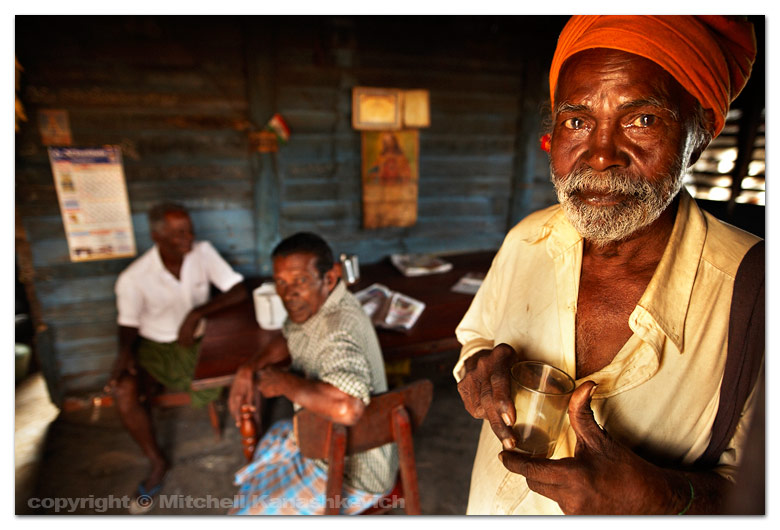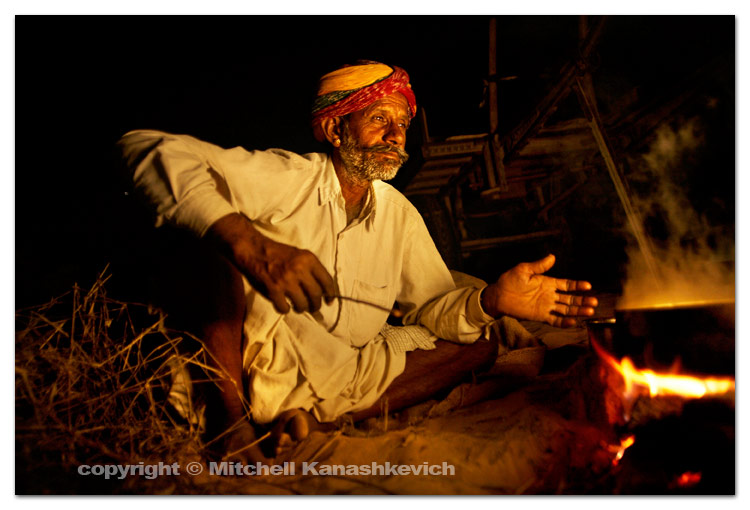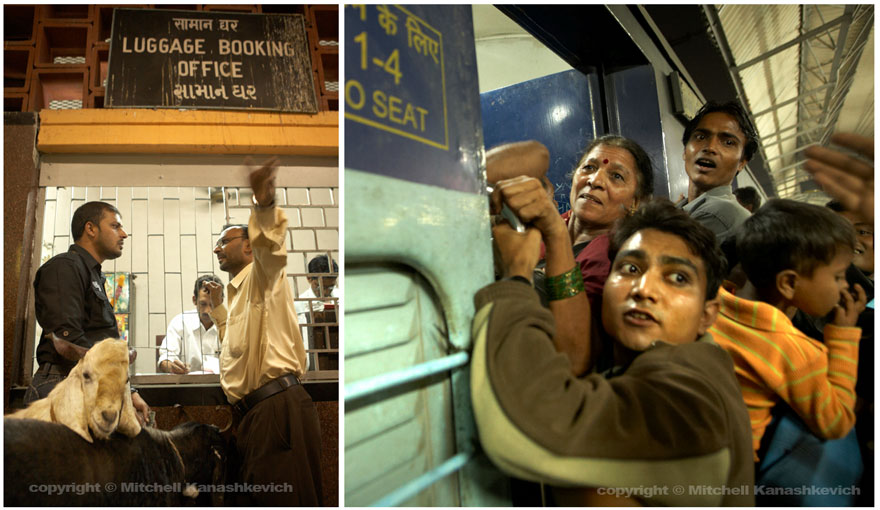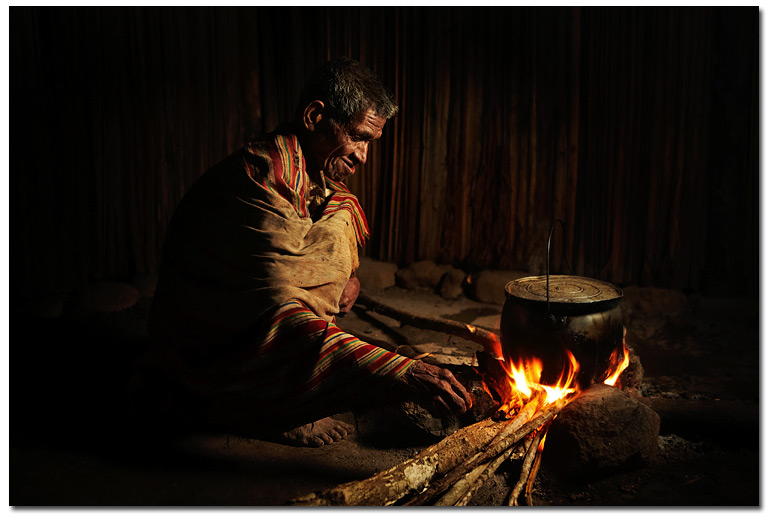Ethiopia is vast, it’s diverse and it is strikingly beautiful. Despite all the difficulties and the challenges that independent travel in Ethiopia brings, the country is an absolutely ideal place for motorcycle riding. I figured from the beginning that to truly explore this fascinating land over a longer period of time, a motorcycle would be the best, most convenient and most affordable mode of transportation. The only problem - a total lack of information anywhere on how to go about doing this, unless you’re not coming with your own motorbike. For this reason I have decided to dedicate a blog post to the very topic of riding around Ethiopia, from acquiring a motorcycle to what’s in store once you hit the road.
Into the Heart of Ethiopia
Dramatic landscapes, kind, warm people and photographic inspiration at every corner - this was my romanticized vision of Ethiopia. Perhaps this vision was what made me all the more disappointed and emotionally deflated, when for over a month I came across more rudeness, dishonesty and overall strange treatment than anywhere else I had traveled. It took time and a lot of luck to meet the right people, to finally find the Ethiopia I dreamt of, but I have found it and, it is A-m-a-z-i-ng! I'll give you a bit of a background story to put things in perspective and then, to the photos.
Breathtaking Philippines
The Philippines are officially going into my books as one of the most beautiful countries I’ve visited, at least as far as breathtaking scenes per square kilometer go, they’re plentiful. The spectacular combination of mountains and water is everywhere and as I might have mentioned a few times, I am truly a sucker for this kind of scenery.
Bangalore, Pune, Mumbai and Good Bye India.
 Bangalore - we didn’t originally plan to stop in this city, but it was the nearest place from where we could get a train to Pune, our final stop before we’d fly from Mumbai. I didn’t want to ride any more either, but all trains to Bangalore were full and you can’t put a motorcycle on a bus.
Bangalore - we didn’t originally plan to stop in this city, but it was the nearest place from where we could get a train to Pune, our final stop before we’d fly from Mumbai. I didn’t want to ride any more either, but all trains to Bangalore were full and you can’t put a motorcycle on a bus.
I planned to ride the 480km from Madurai to Bangalore over two days, but somehow Tanya and I summoned up enough energy and finishing the ride in one day seemed possible.
480km is the longest distance that I have ever ridden in one day on a motorcycle, anywhere. If I were riding in Australia, this distance would not seem that far, really. But this is India and here distance is not only measured by milestones along the road. It is measured by how many cows, chickens, goats, children and women with firewood on their heads you almost hit (because they almost jumped under your wheels) as well as how many buses and trucks almost hit you (because they are bigger and don’t care). It’s a long distance, almost unbearably long. Your butt feels like it’s burning on the motorcycle seat all the way, but you finally pass the pain barrier after 400km, you stop feeling or caring.
Bangalore – the “I.T. City”, “The future of India”. You could have fooled me by the last 20km of road that leads there. Countless potholes, puddles of black water, construction, everywhere and that horrible, dark smoke, the whole thing felt like traveling through a post-apocalyptical landscape, and then you reach the city itself. I’m sure that Bangalore is as amazing as people make it out to be, but whatever it has to offer, it can offer to someone else. I had no time to discover its charm under the black cloud of traffic smoke; I was to finish my “business” and to head off.
At the railway station we sent what was left of the motorcycle back to my Gujarati friend Hardik, who is now in Ahmedabad (Gujarat’s commercial capital). Then it was our turn to go. We’ve become soft when it comes to public transport. We avoid buses because of the loud music and no leg-room; we avoid the sleeper class on the train because of the countless beggars and hawkers that pass through every other minute and we even avoid the “Three-tier AC”, because it still feels somewhat crowded. So we got two “Two-Tier AC” tickets for our 24-hour train ride to Pune. “Two Tier AC” means that you have a compartment with four beds in it and two beds along the corridor, what it does not mean is that you will get the peace and quite that you long for on a tiring journey. I had to force myself to sleep to the sound of continuous burping, farting and snoring of fellow passengers. At 11:30 pm a young boy with a loud, squeaky voice decided it was a good time to have a conversation with his father about Superman. Oh, the joys of travel on the Indian Railways!
Pune – just a one night stop here, a quick catch up with a friend - Rahul, a young man who had recently spent a year in Germany, a year which radically changed the way he now looked at his own city, his country for that matter. The first time I met him I told him that I thought Pune was very modern and developed. “Modern, developed?! No, this place is not like that! You see a high-rise glass building and then you walk inside and you see the people there, spitting on the shiny floors, throwing their shit around. That is modern? Developed?” With his unusually cynical views and his stories about Pune’s Koregaon Park and the infamous “Osho International Meditation Center” Rahul certainly kept me amused and entertained. I hope I meet him again one day.
Mumbai – the city of dreams for millions. I never liked this place very much, but make no mistake about it, it is absolutely, incredibly fascinating.
One more friend to catch up with in Mumbai – Santosh, an independent filmmaker who works as a sound engineer in various Bollywood drama-series out of necessity. Santosh is one of the most intelligent fellows I have come across on my Indian journeys. Whenever I meet him he tells me countless stories about various places we come past in Mumbai. These stories have probably played a part in forming my view of the city – yes there is crime and there are slums, but there is so much more that you will simply pass by if you are visiting by yourself. So many cultures and sub-cultures and everyone has a story, a fascinating story.
As we walked to a restaurant in Colaba, a place where I usually eat, we passed through the parts of the city where the horrors took place in December. It’s eerie when you hear what happened and picture things, but now, just a couple of months later life goes on as before. Sure there are a few policemen with machine guns, but you couldn’t even imagine what took place in the very same streets, where today people are laughing, drinking and celebrating life. That’s how India is. It doesn’t stop for anyone, nor does it compromise or change because you want it to. It is every bit “The Incredible India” of the romanticized advertisements and it is every bit as dark and hopeless as its worst slums, its deranged beggars and its corrupt politicians.
This trip has exhausted us more than any of our previous visits to the country. I don’t know why exactly. Perhaps it’s the distance we’ve covered by motorcycle or perhaps it is because we understand things a little more now. The naivety is gone and it is not only the exotic, beautiful India that we see these days. We realize just how hard it can be to survive in this country, to live with dignity or to at least make it possible for your children to live with dignity. We haven’t learned something that we didn’t know before, but it has really hit home this time. Our realization however, doesn’t make this country any less fascinating. It is a matter of time until we come back. Although I want to spend a few years seeing other parts of the world, I know that just like this time, when India calls – you simply pack up and go.
Photo: The image at the top was taken on a previous India trip. I shot it in a neighborhood about 500 meters from the famous Taj Hotel in Mumbai. It wasn’t quite what you’d classify as the slums in India, but not much better. Insane contrast, the richest of the rich were staying at the Taj, while the poorest of the poor were living in less than ideal conditions and all that separated them from each other was a five minute walk. It’s the old cliché about India – the land of extreme contrasts, but it is so true and it is still tough to get your head around the whole concept when it comes to the rich and the poor.
Madurai
 From Kanyakumari it is a 250 km ride to Madurai. We've made it...barely. After over 10,000 km on the road over the past three months, our bodies are aching in places we didn't know could ache. The two-wheeled machine which has been transporting us all this time is "exhausted" too. It experienced another "major injury" - another crack right through the middle of its chasis on the way to Madurai, but somehow we managed to pull through to our destination.
From Kanyakumari it is a 250 km ride to Madurai. We've made it...barely. After over 10,000 km on the road over the past three months, our bodies are aching in places we didn't know could ache. The two-wheeled machine which has been transporting us all this time is "exhausted" too. It experienced another "major injury" - another crack right through the middle of its chasis on the way to Madurai, but somehow we managed to pull through to our destination.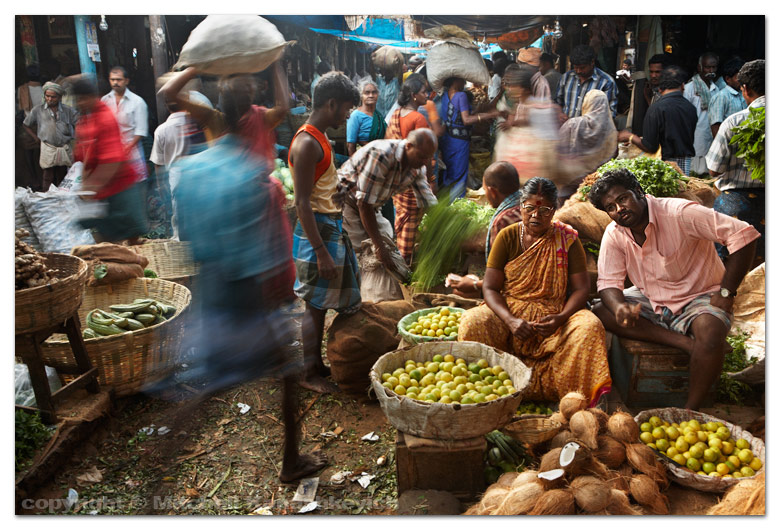
 Madurai is a fascinating city. My short time here would not do it any justice. However, I decided to at least have a peek at it, rather than to simply pass it by. Parts of the city are particularly photogenic. The fruit and vegetable market inside the city is as bustling and challenging to photograph as the fish market in Kollam. I came to this place every morning, I suppose more to absorb the atmosphere than to create any compelling images. Later in the mornings I'd go to the temple, the most famous temple in all of south India and arguably the finest example of Dravidian architecture - the Sri Menakshi. To my huge disappointment there was restoration work being done to the Sri Menakshi during my visit. Its giant, elaborately decorated towers were covered with faded, dry palm leaves. I was left only with post card images of what it looked like and my imagination of how it may look after the restoration.
Madurai is a fascinating city. My short time here would not do it any justice. However, I decided to at least have a peek at it, rather than to simply pass it by. Parts of the city are particularly photogenic. The fruit and vegetable market inside the city is as bustling and challenging to photograph as the fish market in Kollam. I came to this place every morning, I suppose more to absorb the atmosphere than to create any compelling images. Later in the mornings I'd go to the temple, the most famous temple in all of south India and arguably the finest example of Dravidian architecture - the Sri Menakshi. To my huge disappointment there was restoration work being done to the Sri Menakshi during my visit. Its giant, elaborately decorated towers were covered with faded, dry palm leaves. I was left only with post card images of what it looked like and my imagination of how it may look after the restoration.
 Thankfully the inside of the vast temple grounds was very much intact and buzzing with religious activity. I have a strange feeling in Hindu temples; it is as if I am both - a complete alien and totally at home there. All the rituals, the hundreds queuing up for darshan (blessing) or prashad (blessed food) and bowing to the Gods carved out of stone; on the surface none of it makes much sense to someone like me. I'm not religious by any stretch of the imagination, in fact I'd say I'm anti-religious at times, but the essence behind every religion is very human and when I think of that, I, as a human being can connect with it. I feel that behind the multitude of layers, the rituals at Hindu temples or for that matter any sites of worship, stand two universal factors - misery and hope. Misery and hope go hand in hand in and around the Sri Menakshi Temple. A poor farmer's family spends the night on the pavement by a make-shift fire, a deformed man begs for money, a newly-wed couple makes an offering and the fat businessman who has "made it" bows down to the Shiva statue - there is a degree of hope and misery that drives all of these people. They plead for a better life, money, happiness, forgiveness and they all hope that they will be heard by the divine. There isn't an individual in the world that doesn't suffer or hope. And as for surrendering to the divine, if it's not God that a person looks to, it's love, work, alcohol, drugs. The essence remains the same, only the layers around it change. Knowing this makes me feel at ease about the blanks in my knowledge of Hinduism. I can fill in those blanks. What makes me comfortable is the fact that those in the temple are humans, before they are anything else. Their actions are a manifestation of their cultural upbringing, but these actions are driven by the same misery and hope that I and every other human feel.
We spent three days in Madurai. Our next stop is Bangalore. How we have to get there is another story.
Thankfully the inside of the vast temple grounds was very much intact and buzzing with religious activity. I have a strange feeling in Hindu temples; it is as if I am both - a complete alien and totally at home there. All the rituals, the hundreds queuing up for darshan (blessing) or prashad (blessed food) and bowing to the Gods carved out of stone; on the surface none of it makes much sense to someone like me. I'm not religious by any stretch of the imagination, in fact I'd say I'm anti-religious at times, but the essence behind every religion is very human and when I think of that, I, as a human being can connect with it. I feel that behind the multitude of layers, the rituals at Hindu temples or for that matter any sites of worship, stand two universal factors - misery and hope. Misery and hope go hand in hand in and around the Sri Menakshi Temple. A poor farmer's family spends the night on the pavement by a make-shift fire, a deformed man begs for money, a newly-wed couple makes an offering and the fat businessman who has "made it" bows down to the Shiva statue - there is a degree of hope and misery that drives all of these people. They plead for a better life, money, happiness, forgiveness and they all hope that they will be heard by the divine. There isn't an individual in the world that doesn't suffer or hope. And as for surrendering to the divine, if it's not God that a person looks to, it's love, work, alcohol, drugs. The essence remains the same, only the layers around it change. Knowing this makes me feel at ease about the blanks in my knowledge of Hinduism. I can fill in those blanks. What makes me comfortable is the fact that those in the temple are humans, before they are anything else. Their actions are a manifestation of their cultural upbringing, but these actions are driven by the same misery and hope that I and every other human feel.
We spent three days in Madurai. Our next stop is Bangalore. How we have to get there is another story.
At the edge of the world...or India.
 Kanyakumari is where India ends. It's as far south as you can go before you face nothing but endless water. I thought it a rather romantic idea to reach "The world's edge", to ride all the way to Kanyakumari on the motorcycle, and finally we have made it. I've got no idea exactly how many kilometers this place is from Rajasthan, where we began the journey, but mine and Tanya's bottoms say "It's pretty damn far!"
Kanyakumari is where India ends. It's as far south as you can go before you face nothing but endless water. I thought it a rather romantic idea to reach "The world's edge", to ride all the way to Kanyakumari on the motorcycle, and finally we have made it. I've got no idea exactly how many kilometers this place is from Rajasthan, where we began the journey, but mine and Tanya's bottoms say "It's pretty damn far!"
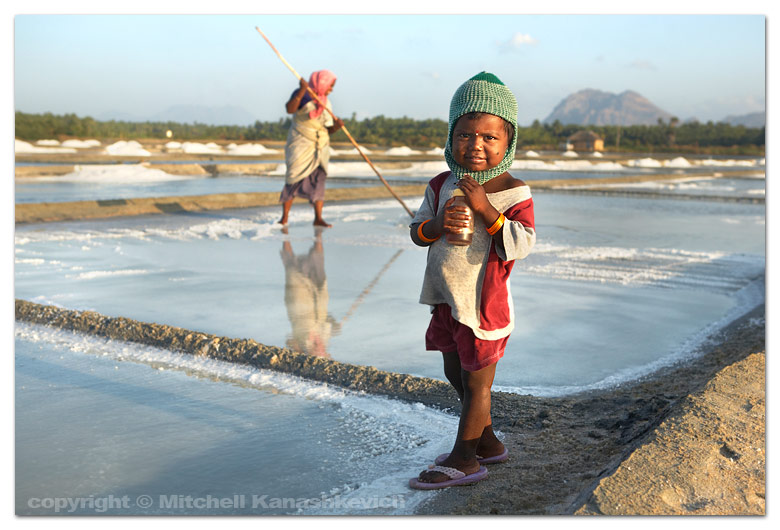 Besides being a major place of religious pilgrimage, the biggest attractions of Kanyakumari are sunrise and sunset watching. Because the town is located on a narrow tip, right at the very bottom of India, it is possible to see the sun rise and set over the sea, and you only have to walk a couple of hundred meters from one spot to the other. As a result every morning there are hordes of mostly local tourists who line up to watch the sunrise and to photograph each other in silly poses at the sunrise point. In the evenings the same deal is repeated at sunset point. The whole area around those two spots is kitschy beyond description and rather irritating, due to the countless numbers of people trying to sell you tourist junk at every corner. But should you venture outside of the tourist zone, you will see a very different side of this region.
Besides being a major place of religious pilgrimage, the biggest attractions of Kanyakumari are sunrise and sunset watching. Because the town is located on a narrow tip, right at the very bottom of India, it is possible to see the sun rise and set over the sea, and you only have to walk a couple of hundred meters from one spot to the other. As a result every morning there are hordes of mostly local tourists who line up to watch the sunrise and to photograph each other in silly poses at the sunrise point. In the evenings the same deal is repeated at sunset point. The whole area around those two spots is kitschy beyond description and rather irritating, due to the countless numbers of people trying to sell you tourist junk at every corner. But should you venture outside of the tourist zone, you will see a very different side of this region.
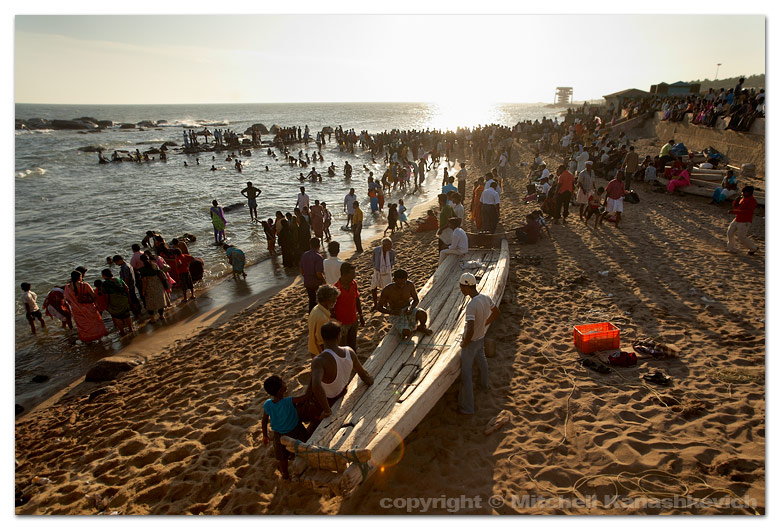 One day we decided to ride along the coastline road that headed north-east from the "Edge of India". The whole way felt strange, fascinating and edge-of-the-worldly. Sparsely populated fishing villages, government housing, likely erected after the 2004 Tsunami and churches, in almost every village, they seemed so out of place due to their grand design and enormous size that dwarfed anything we had seen in Goa.
Without a map, a description of the area in any guidebook or any useful information from the tourist office the ride was exploration for the sake of exploring, a journey into the unknown. There were no demands for pens, chocolates or money along the way. It was beautiful "unadulterated" India. When we got back into town I was faced with the same dilemma that I have encountered a few times on this trip - a bit over three months to cover a relatively small part of India, but ultimately so little time.
We have less than ten days until we fly back to Sydney and so the journey towards Mumbai must begin soon. The next stop is Madurai, we ride from there to Bangalore and travel by train for the remaining days.
One day we decided to ride along the coastline road that headed north-east from the "Edge of India". The whole way felt strange, fascinating and edge-of-the-worldly. Sparsely populated fishing villages, government housing, likely erected after the 2004 Tsunami and churches, in almost every village, they seemed so out of place due to their grand design and enormous size that dwarfed anything we had seen in Goa.
Without a map, a description of the area in any guidebook or any useful information from the tourist office the ride was exploration for the sake of exploring, a journey into the unknown. There were no demands for pens, chocolates or money along the way. It was beautiful "unadulterated" India. When we got back into town I was faced with the same dilemma that I have encountered a few times on this trip - a bit over three months to cover a relatively small part of India, but ultimately so little time.
We have less than ten days until we fly back to Sydney and so the journey towards Mumbai must begin soon. The next stop is Madurai, we ride from there to Bangalore and travel by train for the remaining days.
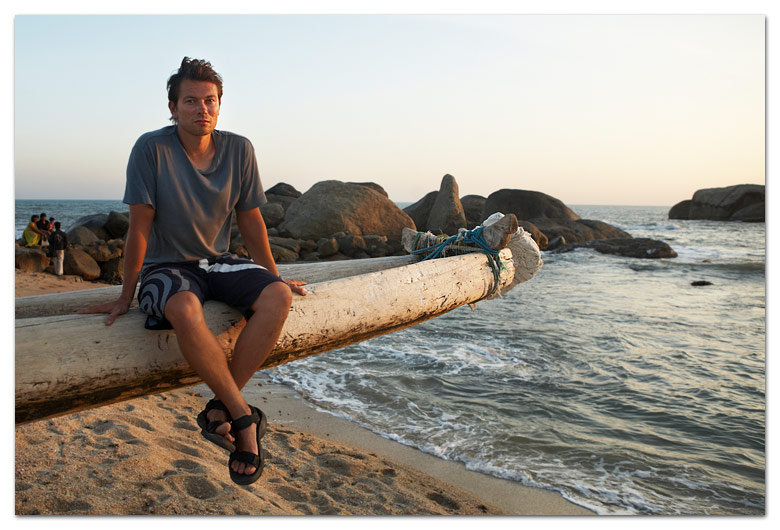 Photos:
Top and middle: A child of a salt worker, patiently waiting for mother with his juice bottle. I photographed this at a salt making field (or whatever you would call a place that makes salt). We came across it while doing our little exploration trip. We came back a few times, wanting to see the mother and son again, but they were no longer there.
Second from the bottom: Tourists at sunset point.
Bottom: This one's for my mum. She hasn't seen her son in over four months. Yeah, it's kinda cheesy, but till I get back I guess a photo is all she can see of me.
Photos:
Top and middle: A child of a salt worker, patiently waiting for mother with his juice bottle. I photographed this at a salt making field (or whatever you would call a place that makes salt). We came across it while doing our little exploration trip. We came back a few times, wanting to see the mother and son again, but they were no longer there.
Second from the bottom: Tourists at sunset point.
Bottom: This one's for my mum. She hasn't seen her son in over four months. Yeah, it's kinda cheesy, but till I get back I guess a photo is all she can see of me.
Last Days in Kerala
 Let me paint you a mental picture - it's early in the morning on Munro Island, the village street is still quite, golden light shines on the greenery that's abundant everywhere you look and a water canal flows to the right of the road. By the same road is a group of little schoolboys, one of them is urinating, facing away from the road. Suddenly he notices Tanya and I pass by on the motorcycle and turns around, without zipping up his pants or finishing his 'business' he screams "Hello! School Pen!
Let me paint you a mental picture - it's early in the morning on Munro Island, the village street is still quite, golden light shines on the greenery that's abundant everywhere you look and a water canal flows to the right of the road. By the same road is a group of little schoolboys, one of them is urinating, facing away from the road. Suddenly he notices Tanya and I pass by on the motorcycle and turns around, without zipping up his pants or finishing his 'business' he screams "Hello! School Pen!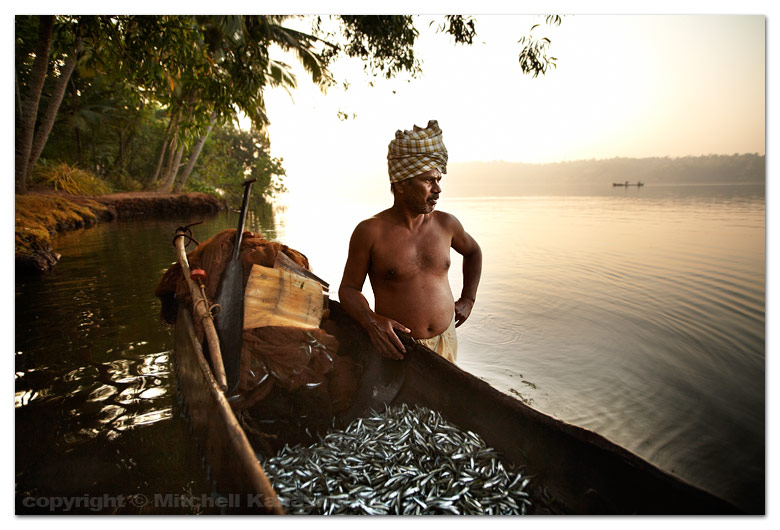 We decided to spend our last few days in Kerala photographing things that you can only see in this state - the backwaters, the boatmen, the sand collectors (see image below). Munro Island was a pretty ideal location. It is beautiful, that is no secret and it's that beauty that attracts countless houseboat tourists and spreads the "Hello, school-pen, chocolate, rupee!" disease among the island's population.The incident described above is ridiculous and that's what I think of the whole thing, it's ridiculous and stupid beyond words. Even the adults murmured those dreadful words, encouraging those I photographed to demand a pen, chocolate or money for being photographed. To the defense of the people in my images, none of them asked me for anything. They really were as dignified as I hope they look in the images.
We decided to spend our last few days in Kerala photographing things that you can only see in this state - the backwaters, the boatmen, the sand collectors (see image below). Munro Island was a pretty ideal location. It is beautiful, that is no secret and it's that beauty that attracts countless houseboat tourists and spreads the "Hello, school-pen, chocolate, rupee!" disease among the island's population.The incident described above is ridiculous and that's what I think of the whole thing, it's ridiculous and stupid beyond words. Even the adults murmured those dreadful words, encouraging those I photographed to demand a pen, chocolate or money for being photographed. To the defense of the people in my images, none of them asked me for anything. They really were as dignified as I hope they look in the images. The negatives aside Munro Island is a special part of Kerala that is hard to resist. Here you can still see people living unhurried, traditional lives. There are no roads through the middle of the island, instead the canals are the island's highways and the only practical way to get from place to place, you constantly see men and occasionally women getting around in small boats. Our highlight on the island was hiring a boat from a village family and going about by ourselves. Judging by the astonished looks on local people's faces it seems that no foreign visitors ever do this, but we loved exploring and learning this particular boat riding technique. In Kerala's backwaters people don't usually paddle with oars, as the waters are rather shallow they have a long piece of bamboo which is used to push off from the ground under water. We got one oar and one long piece of bamboo. After some trial and error Tanya took over the role of the navigator and used the piece of bamboo to push off and change direction when needed. I paddled with the oar and looked for potential photos.The atmosphere on Munro Island is very peaceful and laid back, at least it's like that along the canals. Different story near the roads, where I saw and heard something that absolutely shocked, puzzled and horrified me - loudspeakers on trees and electricity poles. Every day the loudspeakers blasted out some insane tune, so loud that it crackled from distortion. Why would anyone want this in "paradise"? I guess, it's just another Kerala mystery.
The negatives aside Munro Island is a special part of Kerala that is hard to resist. Here you can still see people living unhurried, traditional lives. There are no roads through the middle of the island, instead the canals are the island's highways and the only practical way to get from place to place, you constantly see men and occasionally women getting around in small boats. Our highlight on the island was hiring a boat from a village family and going about by ourselves. Judging by the astonished looks on local people's faces it seems that no foreign visitors ever do this, but we loved exploring and learning this particular boat riding technique. In Kerala's backwaters people don't usually paddle with oars, as the waters are rather shallow they have a long piece of bamboo which is used to push off from the ground under water. We got one oar and one long piece of bamboo. After some trial and error Tanya took over the role of the navigator and used the piece of bamboo to push off and change direction when needed. I paddled with the oar and looked for potential photos.The atmosphere on Munro Island is very peaceful and laid back, at least it's like that along the canals. Different story near the roads, where I saw and heard something that absolutely shocked, puzzled and horrified me - loudspeakers on trees and electricity poles. Every day the loudspeakers blasted out some insane tune, so loud that it crackled from distortion. Why would anyone want this in "paradise"? I guess, it's just another Kerala mystery.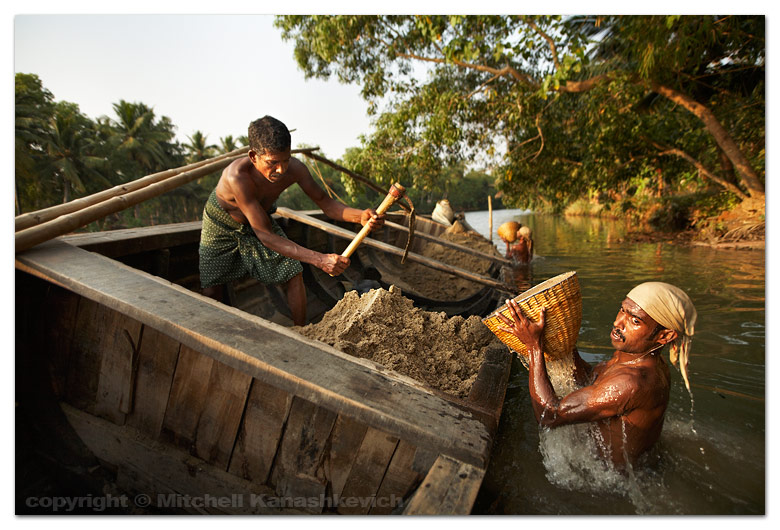
 Alumkadavu, the magical place by the lake which I wrote about in one of my past posts was our last stop in Kerala. We liked it so much the first time that we decided to go back for a day, but, well, the magic was sucked out of it this time around. Why? LOUDSPEAKERS! Thankfully they weren't on trees, but what we heard was bad enough - 24 hours of temple music so loud that we could hear it as if it was at full volume in our own room, and it was actually on the other side of the lake. We came back to this village to absorb the peaceful vibes and to get some photos of people fishing on the lake. Neither happened, but I did get a few images of one of the "public ferry" boatman over a few rides with him (image at the top of the post). He was a nice guy and a hard worker, who didn't mind me snapping away and occasionally rocking the boat, he was too agile to care. He'd walk right along the edge from the font to the back of the boat and vice-versa.
Alumkadavu, the magical place by the lake which I wrote about in one of my past posts was our last stop in Kerala. We liked it so much the first time that we decided to go back for a day, but, well, the magic was sucked out of it this time around. Why? LOUDSPEAKERS! Thankfully they weren't on trees, but what we heard was bad enough - 24 hours of temple music so loud that we could hear it as if it was at full volume in our own room, and it was actually on the other side of the lake. We came back to this village to absorb the peaceful vibes and to get some photos of people fishing on the lake. Neither happened, but I did get a few images of one of the "public ferry" boatman over a few rides with him (image at the top of the post). He was a nice guy and a hard worker, who didn't mind me snapping away and occasionally rocking the boat, he was too agile to care. He'd walk right along the edge from the font to the back of the boat and vice-versa.
I am now writing from Tamil Nadu, a state that shares its' border with Kerala. So, "What will I remember about God's Own Country?". Well, it is remarkably beautiful and full of colorful, ancient traditions that are very much a part of people's lives today. These people are mostly gentle and kind, and dignified, but I guess I'll hear "School-pen, chocolate, rupee!" in my nightmares for some time to come, probably accompanied by temple music playing at full blast from a loudspeaker on a tree.
Photos:
Top to bottom:
- Boatman of a public "ferry", Alumkadavu
- A fisherman with his morning catch at a small fish market, near Munro Island
- Coconut loading. We were riding around Alumkadavu at sunset, looking for something interesting to photograph and found these men loading coconuts into a truck. They were a bit surprised, in a pleasant way, the man on the right opened up one of the coconuts and gifted it to me.
- Sand collecting, Munro Island. Seems like this is a big industry in Kerala. I saw these guys working while we were on our way back from our boat ride. You can't really get a decent shot from the boat, nor can you get it from the shore, so I went chest deep into the water. The workers cracked up with laughter, but continued their job. I shot a few frames. The next image is from their boat, it's worth exploring different angles if you have a chance.
The Little Tea-Shack at the end of "Beach Road"
 During one of our days in Kollam we wanted to find out where the "Beach Road" led to, so we decided to ride it south, as long as it followed the shoreline. After passing a couple of fishing villages and beaches we came to a corner, there the road branched off inland. A small shack stood on that corner, smoke was coming out of its windows and people with tea glasses stood outside. Having come to the end of the "Beach Road" and not having any desire to head back to our room, we got off the motorbike and went into the smoky shack. Inside I found one of my favorite photographic places in Kerala.
During one of our days in Kollam we wanted to find out where the "Beach Road" led to, so we decided to ride it south, as long as it followed the shoreline. After passing a couple of fishing villages and beaches we came to a corner, there the road branched off inland. A small shack stood on that corner, smoke was coming out of its windows and people with tea glasses stood outside. Having come to the end of the "Beach Road" and not having any desire to head back to our room, we got off the motorbike and went into the smoky shack. Inside I found one of my favorite photographic places in Kerala.
The shack was a small eatery that served basic food and tea to fishermen and other village folk. There are countless numbers of such tea-shacks all around India, but this particular one caught my eye. The blue wall, with everything on it was like a tapestry that told a short story about the place and the people who live there. Anyone who's been to South Kerala will recognize the symbols of the state in the photograph at the top of the post. The 'subjects', the owners of the tea-shack - Manuel and Anitha Sebastian are husband and wife; they are Catholic Indians, of whom there seems to be a lot along the coastline of South Kerala.
I made three visits to the tea-shack; I would go there later in the morning, after photographing fishermen by the sea. The top image was taken during my last time there, in the first two I couldn't get the couple together; one or the other would always be busy with customers or in the kitchen. Despite not really being able to speak to each other, sign language and some familiar words helped me explain that I wanted to take some photos. Manuel and Anitha found me rather amusing. They thought it was really funny, or crazy (in which case they masked shock with laughter) when I photographed them through the window which expelled the smoke from their cooking. It was one of these cases where photography seemed to brighten up people's mundane, daily routine and they gladly welcomed me into their lives, for a brief moment in time.
Customers kept coming in and out of the shack. After it was known what I was doing inside, it seemed that some came with the hopes that they too would be photographed. Here are some more images from the "Little Tea-Shack at the end of the Beach Road".
 One early Sunday morning I realized that no one goes to work on Sundays, no fishermen would be going out to the sea. Since I had already gotten up early I headed off to the tea-shack in hopes of catching some customers having tea there. This gentleman had just come from church and was reading the news with a glass of tea in his hand. I asked if I could photograph him, he smiled and agreed. Initially he stared directly into the camera, but I asked him to look a little to the side, to make the portrait more casual.
One early Sunday morning I realized that no one goes to work on Sundays, no fishermen would be going out to the sea. Since I had already gotten up early I headed off to the tea-shack in hopes of catching some customers having tea there. This gentleman had just come from church and was reading the news with a glass of tea in his hand. I asked if I could photograph him, he smiled and agreed. Initially he stared directly into the camera, but I asked him to look a little to the side, to make the portrait more casual.
 Anitha cooking parothas, while Manuel prepares them. Manuel managed to communicate to me that everyday they go through 400 parothas, no small task for a tiny place like theirs. This was taken through the window that sporadically expelled smoke from the cooking fire.
Anitha cooking parothas, while Manuel prepares them. Manuel managed to communicate to me that everyday they go through 400 parothas, no small task for a tiny place like theirs. This was taken through the window that sporadically expelled smoke from the cooking fire.
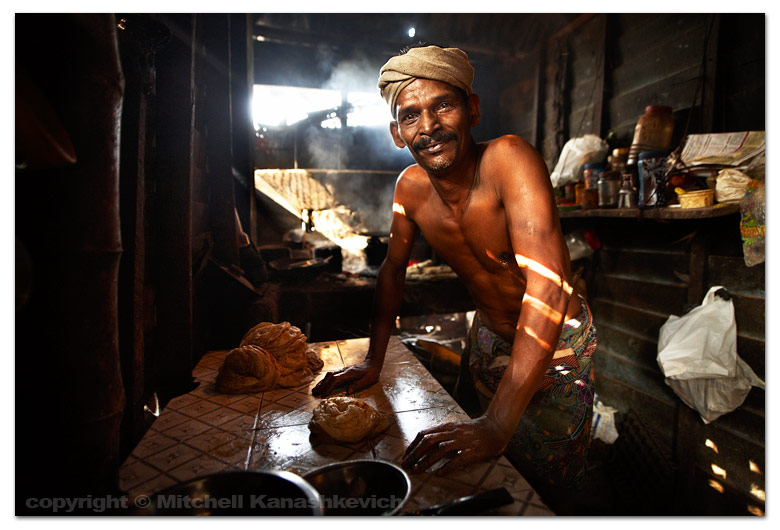 Manuel pauses while making parothas.
Manuel pauses while making parothas.
The rest of the images are pretty self explanatory. All were taken with natural, light that came from the sides, through the windows.
The Spirit of Travel, Cool in the Hills and Tibetan Monks
 If I do not see another Theyyam performance for the rest of my life I will not be devastated. Don't get me wrong, watching these was amazing, surreal, but maybe this is the case of too much of a good thing being not that great. "Theyyam Overload", perhaps. The highlight of our little endeavor into the world of Theyyam must have been the second time we met up with Vipin - the Theyyam artist I mentioned in the previous post. That day, in many ways embodied what travel is all about. It started horribly, we were 'evicted' from possibly the most amazing hotel I've stayed at. Our room's balcony had a view of the Arabian sea. Every morning we watched dolphins splash around within 50 meters from the shore.Long and strange story about the eviction - in short, the hotel was meant for government employees only, but somehow we managed to stay for five days, then some genius finally decided it was enough. The main point is - once you've tasted the good life, it really, really sucks getting back to mediocrity. Getting told to 'vacate' our perfect room and to exchange sea views for views of a sea of traffic on one of the towns busiest and noisiest roads set up what could have been the most disappointing day of our journey, yes the place was that good (and cost about as much as a McDonald's value meal). But that wasn't the end of our bad luck. First we couldn't find any half decent hotel to move to and then my meeting with a professor at the Folklore Academy, the man who had promised to hook me up with some Theyyam artists was cancelled due to an unexpected meeting that could not be put off. I wanted to see him to get reliable information on where I could see more Theyyams. Having been given the wrong information the day before we traveled a couple of hours along a dreadful, traffic filled road for nothing. Now I had to face the fact; I had come to the region to photograph something that I couldn't even find, I really wasn't getting anywhere.
If I do not see another Theyyam performance for the rest of my life I will not be devastated. Don't get me wrong, watching these was amazing, surreal, but maybe this is the case of too much of a good thing being not that great. "Theyyam Overload", perhaps. The highlight of our little endeavor into the world of Theyyam must have been the second time we met up with Vipin - the Theyyam artist I mentioned in the previous post. That day, in many ways embodied what travel is all about. It started horribly, we were 'evicted' from possibly the most amazing hotel I've stayed at. Our room's balcony had a view of the Arabian sea. Every morning we watched dolphins splash around within 50 meters from the shore.Long and strange story about the eviction - in short, the hotel was meant for government employees only, but somehow we managed to stay for five days, then some genius finally decided it was enough. The main point is - once you've tasted the good life, it really, really sucks getting back to mediocrity. Getting told to 'vacate' our perfect room and to exchange sea views for views of a sea of traffic on one of the towns busiest and noisiest roads set up what could have been the most disappointing day of our journey, yes the place was that good (and cost about as much as a McDonald's value meal). But that wasn't the end of our bad luck. First we couldn't find any half decent hotel to move to and then my meeting with a professor at the Folklore Academy, the man who had promised to hook me up with some Theyyam artists was cancelled due to an unexpected meeting that could not be put off. I wanted to see him to get reliable information on where I could see more Theyyams. Having been given the wrong information the day before we traveled a couple of hours along a dreadful, traffic filled road for nothing. Now I had to face the fact; I had come to the region to photograph something that I couldn't even find, I really wasn't getting anywhere.
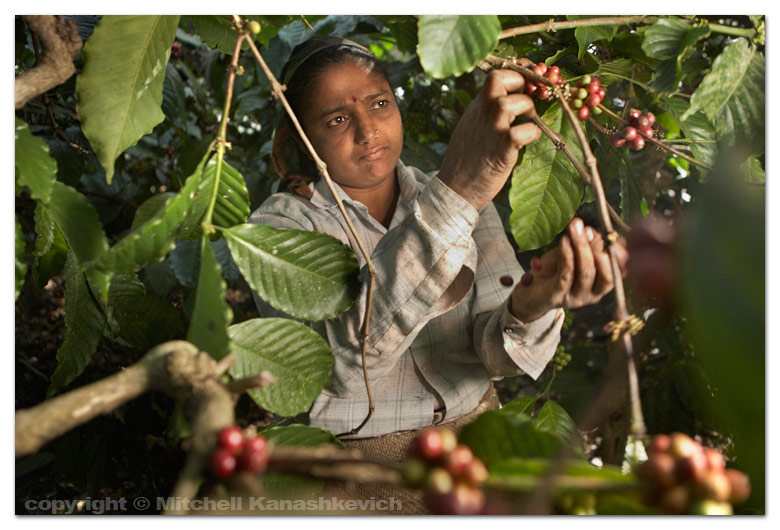 Ready to cry like a child who's been told he's not getting a bicycle after all, I decided instead to go to Vipin's village and give him the Theyyam photos I shot on the night I met him. Vipin was happy to see me and to receive the photos, I couldn't quite match his enthusiasm. But that all changed when he told us that there was a Theyyam performance in his very village. In fact there were two performances that night. These weren't Theyyams aimed at mass audiences, media and tourists, instead I witnessed what was probably as close to Theyyam as it had been hundreds of years ago - raw, sometimes brutal and always full of energy. By late night we had seen a Theyyam performer, possessed by the divine spirit behead four roosters...with his bear teeth, another performer walk through fire and yet another, dance around frantically to some of the most incredible drumming I've heard. We called it a night close to 11pm - real late for rural Kerala. Vipin had been called home a couple of hours before and we were left in the dark, in the middle of nowhere, dependent on our memory to get back. After almost getting lost in the narrow, dark village roads we somehow made it to the main highway that led to Kannur. As we rode the motorcycle back to town, we reflected on the day that pretty much summed up the realities of this life on the road. We were reminded once again that even in the face of the biggest disappointments something amazing could be just around the corner. Knowing that Tanya - my wife was sitting behind me on the bike, ready to face all the obstacles with me also made me realise just how lucky I am.
Ready to cry like a child who's been told he's not getting a bicycle after all, I decided instead to go to Vipin's village and give him the Theyyam photos I shot on the night I met him. Vipin was happy to see me and to receive the photos, I couldn't quite match his enthusiasm. But that all changed when he told us that there was a Theyyam performance in his very village. In fact there were two performances that night. These weren't Theyyams aimed at mass audiences, media and tourists, instead I witnessed what was probably as close to Theyyam as it had been hundreds of years ago - raw, sometimes brutal and always full of energy. By late night we had seen a Theyyam performer, possessed by the divine spirit behead four roosters...with his bear teeth, another performer walk through fire and yet another, dance around frantically to some of the most incredible drumming I've heard. We called it a night close to 11pm - real late for rural Kerala. Vipin had been called home a couple of hours before and we were left in the dark, in the middle of nowhere, dependent on our memory to get back. After almost getting lost in the narrow, dark village roads we somehow made it to the main highway that led to Kannur. As we rode the motorcycle back to town, we reflected on the day that pretty much summed up the realities of this life on the road. We were reminded once again that even in the face of the biggest disappointments something amazing could be just around the corner. Knowing that Tanya - my wife was sitting behind me on the bike, ready to face all the obstacles with me also made me realise just how lucky I am.
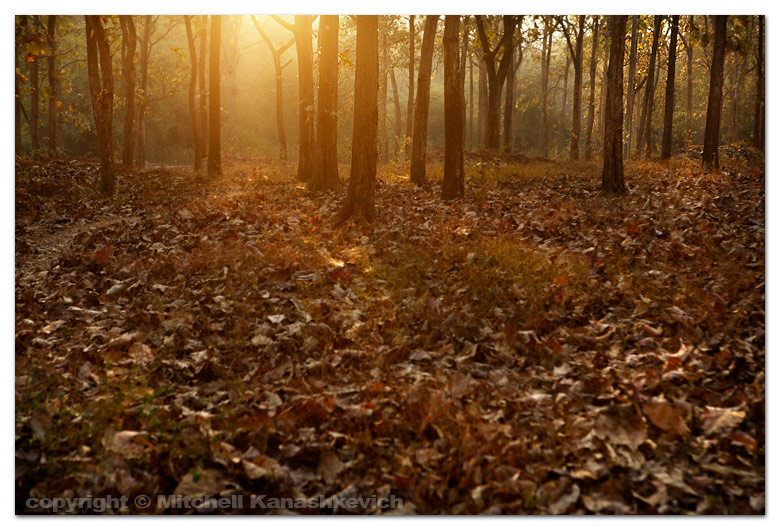 The Theyyam stuff, the heat of coastal Kerala and continuous, hectic rides to the surrounding villages again left us feeling a little drained. We had been contemplating going to Coorg - a hilly region with a cool climate, to refresh for a couple of days, then we'd head back down the coast to Thrissur - one of Kerala's cultural centers. On the map Coorg isn't far from Kannur - 113km. But as always, in India - expect the unexpected. A relatively small patch of the road, known locally as the forest road, was how shall I say - damaged. The damage was so bad that the road looked like it had been bombed continuously for 16 km. I figured that I had traveled on similar roads before, so I didn't make that much of it. BIG mistake! Almost 10km through we started hearing all sorts of noises from our beloved motorcycle. We stopped, I lifted the bike seat and there it was, my worst fear had come true - the motorcycle frame/chasis was broken, snapped right in the middle. To avoid messing things up even more we couldn't continue traveling with all that load and Tanya on the back, and so my poor wife had to walk 6km up a winding, hilly forest road, while I slowly and carefully navigated my way around giant pot holes towards a better road.
The Theyyam stuff, the heat of coastal Kerala and continuous, hectic rides to the surrounding villages again left us feeling a little drained. We had been contemplating going to Coorg - a hilly region with a cool climate, to refresh for a couple of days, then we'd head back down the coast to Thrissur - one of Kerala's cultural centers. On the map Coorg isn't far from Kannur - 113km. But as always, in India - expect the unexpected. A relatively small patch of the road, known locally as the forest road, was how shall I say - damaged. The damage was so bad that the road looked like it had been bombed continuously for 16 km. I figured that I had traveled on similar roads before, so I didn't make that much of it. BIG mistake! Almost 10km through we started hearing all sorts of noises from our beloved motorcycle. We stopped, I lifted the bike seat and there it was, my worst fear had come true - the motorcycle frame/chasis was broken, snapped right in the middle. To avoid messing things up even more we couldn't continue traveling with all that load and Tanya on the back, and so my poor wife had to walk 6km up a winding, hilly forest road, while I slowly and carefully navigated my way around giant pot holes towards a better road.
 We decided to stop for the night at Madikeri - Coorg's biggest town. Our chances of fixing the chasis in this remote region were slim, but Madikeri was our best bet. Again we were facing a very unpleasant situation, but as has happened countless times in India, a stranger came to the rescue. After failed attempts to explain what I need and a few rejections from mechanics and welders who understood, we unexpectedly came across Joe - a catholic Indian man from the coastal city of Cochin. Joe was looking to buy a motor to use for a crop-sorting machine on his spice estate. He came to the same place where we were trying to find out whether our problem can be fixed. After hearing our predicament Joe took it upon himself to help out the guests in his country. The next day his two equally helpful nephews Jeremy and Ronald were involved and although the task became a job of epic proportions (Madikeri is a relatively small town) it was done by the end of the afternoon. It was a little late to head to our next destination and we decided we'd stay another night in Madikeri, that was until Ronald, Joe's nephew called. Ronald found out that I was interested in checking out some tea or coffee plantations/estates and so he invited us over to his estate for the night. We couldn't resist. Another potentially horrible situation had turned in our favor. The next morning we woke up in a mini forest of coffee and pepper bush, as well as some very tall (and apparently expensive) trees. The golden light played it's role in making everything magic. Tanya and I wondered around, appreciated the surroundings and shot a few frames. We expressed our gratitude to our new friends, who saved us and turned a potential disaster into one of the most memorable moments of our journey. Then it was time to move on. Next stop - Bylakuppe - a Tibetan refugee settlement. That's where we are as I type.
We decided to stop for the night at Madikeri - Coorg's biggest town. Our chances of fixing the chasis in this remote region were slim, but Madikeri was our best bet. Again we were facing a very unpleasant situation, but as has happened countless times in India, a stranger came to the rescue. After failed attempts to explain what I need and a few rejections from mechanics and welders who understood, we unexpectedly came across Joe - a catholic Indian man from the coastal city of Cochin. Joe was looking to buy a motor to use for a crop-sorting machine on his spice estate. He came to the same place where we were trying to find out whether our problem can be fixed. After hearing our predicament Joe took it upon himself to help out the guests in his country. The next day his two equally helpful nephews Jeremy and Ronald were involved and although the task became a job of epic proportions (Madikeri is a relatively small town) it was done by the end of the afternoon. It was a little late to head to our next destination and we decided we'd stay another night in Madikeri, that was until Ronald, Joe's nephew called. Ronald found out that I was interested in checking out some tea or coffee plantations/estates and so he invited us over to his estate for the night. We couldn't resist. Another potentially horrible situation had turned in our favor. The next morning we woke up in a mini forest of coffee and pepper bush, as well as some very tall (and apparently expensive) trees. The golden light played it's role in making everything magic. Tanya and I wondered around, appreciated the surroundings and shot a few frames. We expressed our gratitude to our new friends, who saved us and turned a potential disaster into one of the most memorable moments of our journey. Then it was time to move on. Next stop - Bylakuppe - a Tibetan refugee settlement. That's where we are as I type.
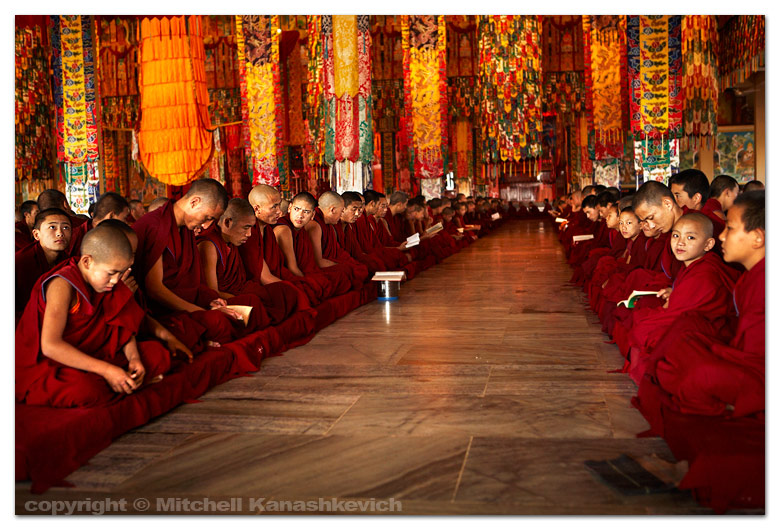 Bylakuppe is a peaceful place, full of maroon robed monks and monasteries. It ain't Himalaya, but there's still something special about it. Monasteries and monks are always photogenic, so we've already spent a few days photographing here. Tomorrow we head off on a little detour, to avoid the dreadful 'Forest Road'. We'll probably end up in Mysore for a few days, then it's on to Wayanad. This cool climate and nature stuff has inspired me to spend some more time up in the hills, in India's forested areas.
Now to the photos. From top to bottom: Monks rushing out after the Morning Prayer, Sera Jey Temple, Bylakuppe. Coffee berry picker at Ronald's estate, Coorg. Morning along the road in Coorg, Kushalnagar region. A mahout washing his elephant at the Dubare Forest Reserve (Forgot to mention we went there. Shot this while standing knee high in water filled with elephant urine and crap ) Bottom: Inside of Sera Jey Temple, Bylakuppe.
Bylakuppe is a peaceful place, full of maroon robed monks and monasteries. It ain't Himalaya, but there's still something special about it. Monasteries and monks are always photogenic, so we've already spent a few days photographing here. Tomorrow we head off on a little detour, to avoid the dreadful 'Forest Road'. We'll probably end up in Mysore for a few days, then it's on to Wayanad. This cool climate and nature stuff has inspired me to spend some more time up in the hills, in India's forested areas.
Now to the photos. From top to bottom: Monks rushing out after the Morning Prayer, Sera Jey Temple, Bylakuppe. Coffee berry picker at Ronald's estate, Coorg. Morning along the road in Coorg, Kushalnagar region. A mahout washing his elephant at the Dubare Forest Reserve (Forgot to mention we went there. Shot this while standing knee high in water filled with elephant urine and crap ) Bottom: Inside of Sera Jey Temple, Bylakuppe.
New Year, Giant Prawns and Kerala...finally
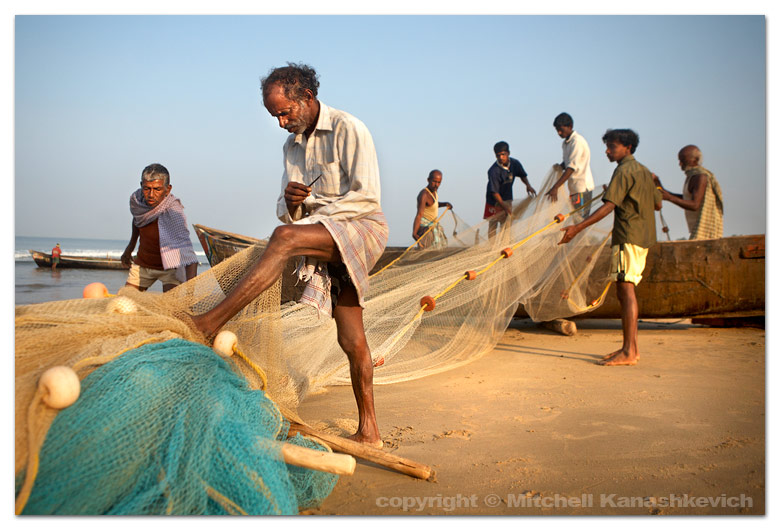 Yes, my first blog entry for 2009 is well over due, but we are on the road after all and we are exhausted. Yesterday we finally arrived in "God's Own Country" - Kerala. We watched sunset from the beach, but I was so tired that I fell asleep right there on the sand. We are already around 2000km from Bundi - the place where we started our motorcycle journey. The way from Goa to Kerala isn't so long, but it has been more tiring than our other journeys. National Highway 17 is going into my books as one of the crappiest major roads in India, albeit one of the more beautiful.
Our New Year's Eve was one of the best I've had, ever. In Arambol, Goa Tanya and I became friends with a girl from Moscow who shared our, well more like my craze for seafood. She joined in our plan to buy seafood for cheap at the fish market and cook it by the fire on the beach on New Year's Eve. The evening went even better than planned; we somehow managed to find an empty beach, lit a fire and cooked our gigantic prawns and an equally gigantic crab. Of course being really far from the action in Goa is impossible and so we were treated to a few rounds of fireworks from the neighboring beaches.
Yes, my first blog entry for 2009 is well over due, but we are on the road after all and we are exhausted. Yesterday we finally arrived in "God's Own Country" - Kerala. We watched sunset from the beach, but I was so tired that I fell asleep right there on the sand. We are already around 2000km from Bundi - the place where we started our motorcycle journey. The way from Goa to Kerala isn't so long, but it has been more tiring than our other journeys. National Highway 17 is going into my books as one of the crappiest major roads in India, albeit one of the more beautiful.
Our New Year's Eve was one of the best I've had, ever. In Arambol, Goa Tanya and I became friends with a girl from Moscow who shared our, well more like my craze for seafood. She joined in our plan to buy seafood for cheap at the fish market and cook it by the fire on the beach on New Year's Eve. The evening went even better than planned; we somehow managed to find an empty beach, lit a fire and cooked our gigantic prawns and an equally gigantic crab. Of course being really far from the action in Goa is impossible and so we were treated to a few rounds of fireworks from the neighboring beaches.
I guess from my limited time in Goa I can say that it is indeed a different world to the rest of India. Those who don't venture outside of this tiny state would certainly get a very warped idea of what India is like. I mean where else in India could you see bikini clad European girls riding scooters? The thing is they don't even usually get stared at (at least not in Arambol). It was an absolute shock to me and Tanya at first, simply didn't make sense that this was happening in a country where the only women showing skin are Bollywood stars that can only be seen on TV and on billboards, in a country where for most part men and women do not even hold hands in public, where village women rarely unveil their faces. Perhaps the bikini girls were oblivious to that India or perhaps they had been there and had enough, it felt like this was their turf and their turn to make the rules.
There are many things that make Goa very different from the 'real' India. It's cleaner, it's richer and dare I say more open minded. This open mindedness often leads to 'progress' but just as often it destroys local cultures and ways of living. I avoided Goa over my past three trips to India because I expected to see nothing more than hoards of tourists and dreadlocked, grass smoking foreigners. In many cases that held true, but in many others it did not. The culture is still there, it's in the churches of Old Goa, the streets of Panjim, it is probably in the villages away from the coast. Given enough time before my trip ends I plan to come back and peak into Goa's quieter pockets.
Our next stop was in North Karnataka, Gokarna - a small temple town with a hippy vibe. There are no parties like those of Goa in Gokarna. It seems that the foreigners who come here come to simply chill and get an occasional sample of the local culture, which exists oblivious to the dreadlocks, bikinis and newly opened cafes with foreign menus.
Every morning beautifully dressed Brahmins (priests) can be seen going in an out of temples, pilgrims are praying, making offerings and occasionally wetting their feet in the sea, while at the North end of Gokarna beach old fishermen mend their nets and set out to make a living the same way that their forefathers have for generations. The really big draw cards of the region are the quieter, ideallyc beaches of Om and Kudle. I have only been to Om and while the amount of rubbish that covers the path down to the beach is abhorring, the beach itself is clean and very beautiful.
I wish I had unlimited time to stay longer in Gokarna, but I don't and so I had to move on after three days. On our final day in the area I had to satisfy my seafood lust once again, still joined by our friend from Moscow we bought a whole load of crabs and some prawns at the nearby fish market town of Kadidi and had the stuff barbequed for us at a beachside restaurant/shack. What a meal, the only problem or perhaps a blessing is the fact that I still can't look at seafood three days later, it will pass, I think. Our Moscow friend has joked that I should quit photography and write a guidebook for budget culinary travelers on where to find cheap food, where to have it cooked etc. Hey, might not be such a bad idea.
Right now we're in Kannur - a town in an area of North of Kerala that is famous for Theyyam - a ritualistic dance where the performer is possessed by a higher power and becomes the embodiment of a God. From the photos I've seen it's pretty colorful and amazing. This is what I'm here for. It's Theyyam season and a performance/ritual happens almost daily. I'll see my first Theyyam tomorrow.
Kerala is also India's most educated state with over 90% literacy rate. How is this manifested in everyday life? Well, more people can speak good English, that's the obvious thing that stands out. However this wouldn't be India if there were no surprises. This evening we visited a fort built by the Portuguese in the 1500s. At the entrance sat a man, a simple looking mustached fellow with a badge "Tourist Police" on the left side of his shirt.
I had always thought that the caretakers/tourist police or whoever sits at the entrance of monuments are just there to fill a spot, to get paid a nominal wage because they do not have the qualifications to do much else. Boy was I wrong and I realized it as soon as the "Tourist Policeman" opened his mouth. In very good English he started to tell me in great detail about the fort. But that wasn't the surprise. Suddenly the man said - "Two years ago I had a book published about the history of this fort." - "Really?" - "Yes" I still found it slightly hard to believe until I saw it with my very own eyes - a book with a picture of the fort and Vasco Da Gamma at the front and a photo of the mustached Tourist Policeman smiling on the back cover.
On a side note, I have forgotten to mention that there is an interview with me HERE. Also for those who have enquired about my workshops, I do not know when the next one will be at this stage. However I will recommend this:
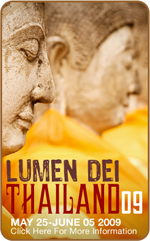 If you are lucky and can still get a spot you could be learning from some photographers who I really respect. Matt, David and Gavin are three guys who really know their stuff, as well as the often overlooked business side of travel photography. Anyway, in short hurry or book for next year, if it's possible.
If you are lucky and can still get a spot you could be learning from some photographers who I really respect. Matt, David and Gavin are three guys who really know their stuff, as well as the often overlooked business side of travel photography. Anyway, in short hurry or book for next year, if it's possible.
My images above: (Top) Fishermen preparing the nets before they go out to sea, Gokarna, Karnataka (Middle) A Brahmin (priest) outside a temple, Gokarna (Bottom) A scene at Malpe Harbour, Karnataka. Those marks in the sky are eagles and crows circling, looking for the odd fish to grab from the piles of what seemed to me like some sort of sea cockroaches.
Back on the Road, Serenity at Maheshwar and Sadhus
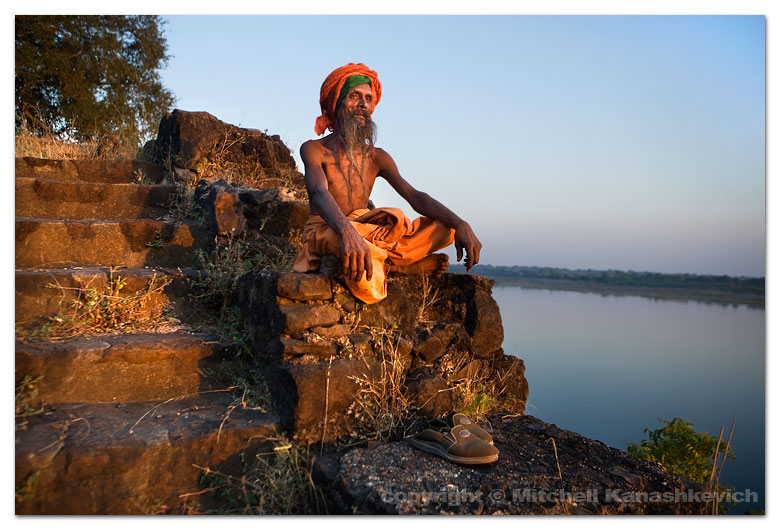 The last ten or so days have been intense. We have covered over 1000km of road, sometimes extremely bad road, pot-holed, narrow and full of half-competent drivers. But riding on these kinds of roads often brings unexpected amusement. Close to the Madhya Pradesh/Rajasthan border we came across a 'holy man'. He had obviously been walking along the road for a long time, but he was being followed by an entourage - people with sun-blocking umbrellas and cars with large signs promoting his pilgrimage. Not so unusual for India, except for the fact that the man was completely naked.Less than one hundred kilometers later we were treated to a sighting of an almost literal clash of two worlds - the ancient and the modern. A caravan of bejeweled tribal women with camels and children (most of them on top of the camels) crossed the road as cars and trucks moving at insane speeds somehow managed to slow down in time not to run anyone over.
Our first stop was Ujjain - a place of pilgrimage that holds a great significance for Hindus around India. Every twelve years it hosts what is possibly the largest gathering of humans on earth - the Kubh Mela. The next mela is eight years away, so the city was rather subdued when we visited. Ujjain offers a glimpse of the exotic Hindu India that we often see on TV and in picture books. Every morning devotees bathe in the holy waters of the Shipra river, they wash away their sins and make offerings. The Brahmins (priests) at the riverside temples perform various religious ceremonies, the way their ancestors have for hundreds of years, the only difference now seems to be the priests' short attention span, evident from their constant checking of the mobile phone right in the middle of the ceremonies.
Our next stop at the small town of Maheshwar by the Narmada river, was meant to last for a day and a morning, but once we felt the peaceful rhythm of life here and the warmth of the locals, we got 'sucked' in and stayed three days. Maheshwar is also a place for religious pilgrimage, but it is much, much lower scale. It is what I imagine India was like a long time ago, before the whole modernization and population explosion occurred. There is definitely magic in the air, perhaps because it hasn't yet been killed by the blaring sounds from stereo systems and the large rubbish throwing crowds, so common around similar places. A walk along the riverside in Maheshwar is one of the most serene experiences one is likely to have in India and a swim in the Narmada river here at sunset is like nothing else (yes, I braved it and went in, but Narmada is not as polluted as India's other rivers). Floating in the water and seeing the huge fort and the numerous temples towering above, while the setting sun’s rays painted everything gold felt absolutely surreal.
We would have liked to stay longer in Maheshwar, but at this stage time is not a luxury we possess. Our stop at Nasik (another Kumbh Mela destination) was brief, but the next one at Pune was longer than expected. Not that I am complaining, since Pune turned out to be quite fascinating for a place where I didn't even think about photographing, but more of that in the next post.
I am posting some images from Maheshwar. The first two (one at the top one below) are of a Sadhu we met at a small, isolated temple on a hill overlooking the Narmada. Sadhus are also known as holy men, ascetics and saints in India. In reality they are often very far from anything holy or spiritual. Most that I had come across were simply wanderers, beggars and in worst cases scam artists, in fact I am always cautious when a Sadhu asks me to come over and speak with him. Usually any conversation simply leads to how I should give him money, but there are also plenty of stories of naive travelers being drugged, robbed and having other not so nice things happen to them. If I am in famous pilgrimage places full of tourists I will not even waste my time, but here I was in Maheshwar (which only seems to get a trickle of visitors) and this Sadhu gestured with his hand from his temple for me and my wife to come up. While the isolated location seemed like an ideal place for something bad to happen we decided to go, we simply wouldn't drink or eat anything offered to us, paranoid maybe, but safe. The Sadhu spoke less English than I spoke Hindi and that is about 20 words. Our conversation revealed which pilgrimage places he had been to (very many). He had many children and whether they were biological or spiritual was not easy to understand, but they did live all over the world. Suddenly he got me to right down an address, which turned into a collection of random names and places in different countries. His children maybe? Finally I managed to communicate that I wanted to photograph him by the window of his room, he agreed, I asked if he could smoke his chillum (the pipe used to smoke opium) he did. There wasn't quite enough light in the room to photograph without setting the shutter speed too low, so again Tanya helped with the flash from the window side, used in a softbox at 1/64 of the power. The next image was taken outside of the Sadhu's temple. The sun was setting and the location seemed perfect, with the Narmada in the background. After the little photo session the Sadhu invited us to follow him somewhere, just for five minutes. We got a bit worried, as that's how those horror stories usually started, but again decided to take the risk. At this stage the Sadhu's nature seemed quite friendly, even if a little mad. We followed along a narrow path surrounded by vegetation and ended up at what seemed like another temple and a small room. There were houses with people nearby and one young man spoke some English. I asked him whether the Sadhu wanted us to come with him for some particular reason. – No, he just wanted to offer you food and milk, just ‘time pass’. It really didn’t seem like the Sadhu had too much to offer, so we politely declined and instead took down the address of his temple, to send him the photographs.
The last ten or so days have been intense. We have covered over 1000km of road, sometimes extremely bad road, pot-holed, narrow and full of half-competent drivers. But riding on these kinds of roads often brings unexpected amusement. Close to the Madhya Pradesh/Rajasthan border we came across a 'holy man'. He had obviously been walking along the road for a long time, but he was being followed by an entourage - people with sun-blocking umbrellas and cars with large signs promoting his pilgrimage. Not so unusual for India, except for the fact that the man was completely naked.Less than one hundred kilometers later we were treated to a sighting of an almost literal clash of two worlds - the ancient and the modern. A caravan of bejeweled tribal women with camels and children (most of them on top of the camels) crossed the road as cars and trucks moving at insane speeds somehow managed to slow down in time not to run anyone over.
Our first stop was Ujjain - a place of pilgrimage that holds a great significance for Hindus around India. Every twelve years it hosts what is possibly the largest gathering of humans on earth - the Kubh Mela. The next mela is eight years away, so the city was rather subdued when we visited. Ujjain offers a glimpse of the exotic Hindu India that we often see on TV and in picture books. Every morning devotees bathe in the holy waters of the Shipra river, they wash away their sins and make offerings. The Brahmins (priests) at the riverside temples perform various religious ceremonies, the way their ancestors have for hundreds of years, the only difference now seems to be the priests' short attention span, evident from their constant checking of the mobile phone right in the middle of the ceremonies.
Our next stop at the small town of Maheshwar by the Narmada river, was meant to last for a day and a morning, but once we felt the peaceful rhythm of life here and the warmth of the locals, we got 'sucked' in and stayed three days. Maheshwar is also a place for religious pilgrimage, but it is much, much lower scale. It is what I imagine India was like a long time ago, before the whole modernization and population explosion occurred. There is definitely magic in the air, perhaps because it hasn't yet been killed by the blaring sounds from stereo systems and the large rubbish throwing crowds, so common around similar places. A walk along the riverside in Maheshwar is one of the most serene experiences one is likely to have in India and a swim in the Narmada river here at sunset is like nothing else (yes, I braved it and went in, but Narmada is not as polluted as India's other rivers). Floating in the water and seeing the huge fort and the numerous temples towering above, while the setting sun’s rays painted everything gold felt absolutely surreal.
We would have liked to stay longer in Maheshwar, but at this stage time is not a luxury we possess. Our stop at Nasik (another Kumbh Mela destination) was brief, but the next one at Pune was longer than expected. Not that I am complaining, since Pune turned out to be quite fascinating for a place where I didn't even think about photographing, but more of that in the next post.
I am posting some images from Maheshwar. The first two (one at the top one below) are of a Sadhu we met at a small, isolated temple on a hill overlooking the Narmada. Sadhus are also known as holy men, ascetics and saints in India. In reality they are often very far from anything holy or spiritual. Most that I had come across were simply wanderers, beggars and in worst cases scam artists, in fact I am always cautious when a Sadhu asks me to come over and speak with him. Usually any conversation simply leads to how I should give him money, but there are also plenty of stories of naive travelers being drugged, robbed and having other not so nice things happen to them. If I am in famous pilgrimage places full of tourists I will not even waste my time, but here I was in Maheshwar (which only seems to get a trickle of visitors) and this Sadhu gestured with his hand from his temple for me and my wife to come up. While the isolated location seemed like an ideal place for something bad to happen we decided to go, we simply wouldn't drink or eat anything offered to us, paranoid maybe, but safe. The Sadhu spoke less English than I spoke Hindi and that is about 20 words. Our conversation revealed which pilgrimage places he had been to (very many). He had many children and whether they were biological or spiritual was not easy to understand, but they did live all over the world. Suddenly he got me to right down an address, which turned into a collection of random names and places in different countries. His children maybe? Finally I managed to communicate that I wanted to photograph him by the window of his room, he agreed, I asked if he could smoke his chillum (the pipe used to smoke opium) he did. There wasn't quite enough light in the room to photograph without setting the shutter speed too low, so again Tanya helped with the flash from the window side, used in a softbox at 1/64 of the power. The next image was taken outside of the Sadhu's temple. The sun was setting and the location seemed perfect, with the Narmada in the background. After the little photo session the Sadhu invited us to follow him somewhere, just for five minutes. We got a bit worried, as that's how those horror stories usually started, but again decided to take the risk. At this stage the Sadhu's nature seemed quite friendly, even if a little mad. We followed along a narrow path surrounded by vegetation and ended up at what seemed like another temple and a small room. There were houses with people nearby and one young man spoke some English. I asked him whether the Sadhu wanted us to come with him for some particular reason. – No, he just wanted to offer you food and milk, just ‘time pass’. It really didn’t seem like the Sadhu had too much to offer, so we politely declined and instead took down the address of his temple, to send him the photographs.
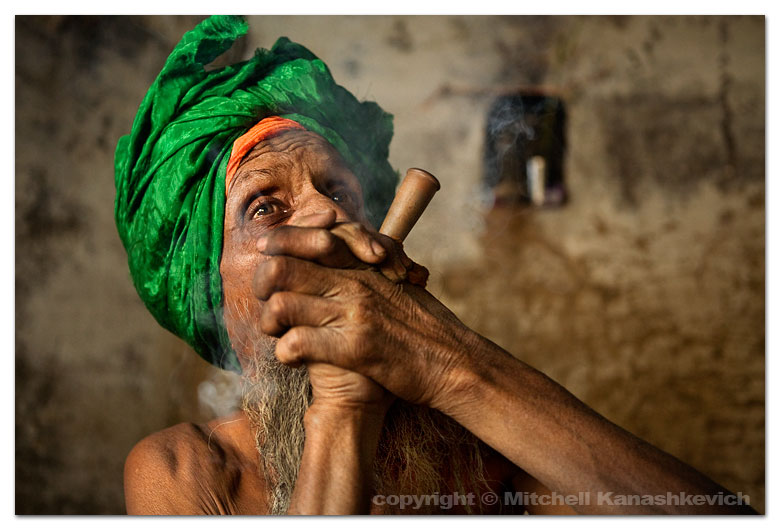 The rest of the photos are just grabs of everyday life by the Narmada river.
The rest of the photos are just grabs of everyday life by the Narmada river.
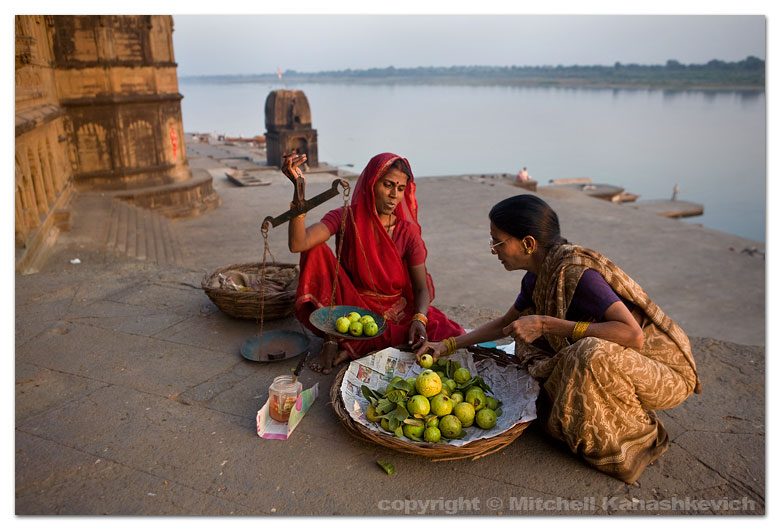
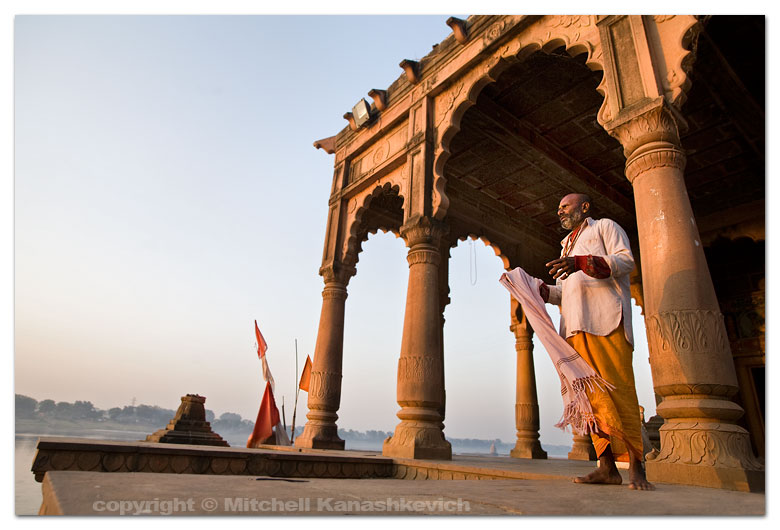
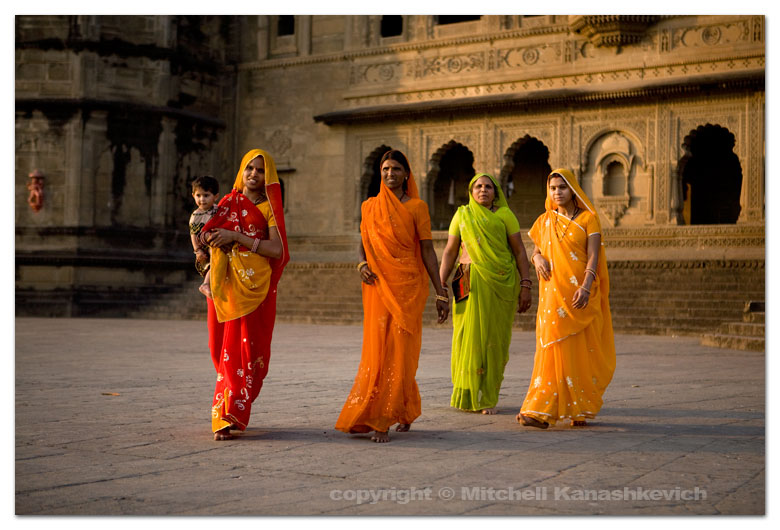
Pimpin my ride, Indian Railways and Kolayat Fair
I’ve been waiting for something eventful to happen before posting, but events often happen in bunches and really quickly. Having to travel for almost 1000 km over the last five days, time is the luxury which I do not have. I’ll have to be relatively brief.
At this stage, almost three weeks into my journey I feel that I have already experienced the full range of the emotions that India evokes. Yes, the people here are absolutely amazing, but it is also incredible that I can still get so frustrated. A few times I have already had to break the rule of not riding the motorcycle after dark. I’ve done it out of necessity not by choice and I will say it again – DO NOT RIDE AFTER DARK IN INDIA, particularly not in Rajasthan. The truck and bus drivers are maniacs and they can kill you, given enough attempts. How? By blinding you with the high beam and taking up your lane as they overtake something slow-moving in the opposite direction to you – e.g. camel cart. I’ve reached the boiling point a few times already.
My motorcycle luggage carrier drama is now hopefully over. I “pimped my ride” in an area of Ahmedabad, Gujarat where young lads with too much money modify their Indian-made-bikes to look like foreign models. I wanted no such thing. My desire was to simply strengthen my motorcycle frame to withstand the rigors of bearing the weight of my luggage on rural Indian roads. A frustrating, but overall productive experience. I got what I wanted, albeit almost a day later than promised, with just enough time to book my vehicle as luggage on the Indian Railways. The experience of sending your motorcycle somewhere on the train surely takes at least a few days off your life. Finding where to go, who to talk to, how much to really pay and doing it all before the train departs – it’s really not that fun. The bike and we went from Ahmedabad to Jodhpur, on the train, from there we rode to Bikaner, then to Bundi with a one-night stop in Pushkar. Bundi is the final destination for now. From here I will lead a private photography workshop for 17 days.
I have not spent enough time anywhere yet to really absorb the places I’ve been to. One pleasant surprise on the way was the Kolayat fair – dubbed “Mini Pushkar” (the famous camel fair). Here we met two old cameleers with whom we will likely go out into the desert, just for a short journey for the workshop, around some unspoilt traditional villages. Going with them seems like a much better alternative to hiring a jeep and a driver from a Tour Company which I spoke to. I hate being the tourist who is taken around like a spectator in a zoo and then gets milked for every last penny. The tour operator promised me villages which are not ‘touristy’. A ‘touristy’ village in the desert Rajasthan usually means being followed by villagers who ask for rupees, chocolates, pens, soap, shampoo and whatever other things previous tourists were ‘kind’ enough to leave. ‘Not touristy’ means that previous visitors and operators have basically not screwed the place up. I asked whether the company’s driver knew of such villages – Yes, he has taken many tourists there! Replied the company owner. “Hmm, yeah, what you say really makes sense. A good reason to pass.” I thought to myself.
On the other hand the old cameleers instantly made me feel comfortable around them. Perhaps it was the smell of camel dung, unwashed clothes, bidi smoke and their calm voices - characteristics typical of cattle and camel herders around the region. I had become very familiar with such people in my last India trip and have nothing but positive associations with them – real, unpretentious folk who often seem to belong to a world that is different than that of their neighbors.
I’m off to organize the final details of the workshop. I will be quite intensely involved with it over the next 17 days or so and don’t know how often I’ll be able to post. I’ll try my best. Posting some photos here, just some diary shots from the past week. (The image at the top is a camel herder preparing dinner after dark at the Kolayat fair. I wanted to see how people would react to me using an off camera flash in a soft box, whether it would draw too much attention, thankfully not.)
Riding a motorcycle in India
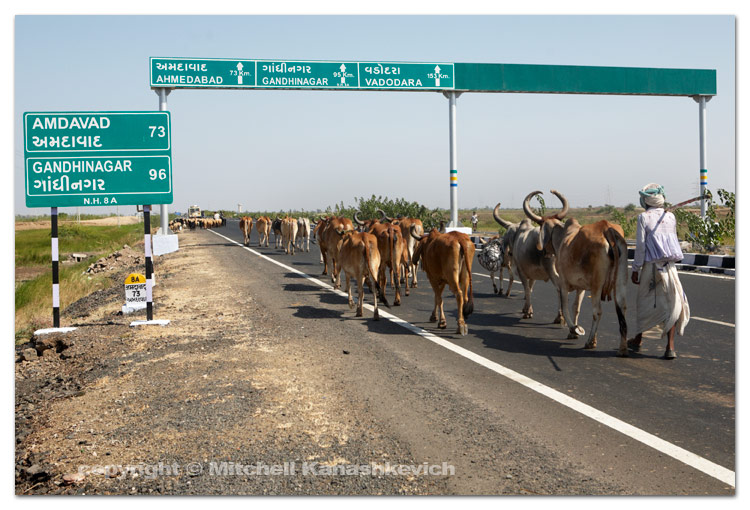 The ride to Ahmedabad was a reminder why I love this life on the road. Just me and my wife Tanya, riding through what are often beautiful, unfamiliar lands, experiencing everything together – this has been a large part of our lives over the last three years. In many ways it is as romantic as some may think, but there is another side, one which is not so nice.The beauty you see is sometimes matched by the horror (to me at least) - the amount of killed dogs on the roads is impossible to count, the scenery is not always ideal - ugly buildings and industrial, smoke belching areas really do not make for inspirational riding. And then there are the road users, who, well let’s just say they do not always act as one might expect, nor do the pedestrians – I’ve had much more close calls than I would have liked to, over the years. To top everything off there is the ‘pain in the butt factor’ (literally) – over a long journey a motorcycle seat becomes the least comfortable place in the world and even a roach-infested hotel starts to seem like a welcoming alternative.
Riding around India is not easy, but it is far from impossible and not as insane as many visitors to India may think. All that one needs is the knowledge of how the Indian roads work, once things begin to make sense everything starts to feel much less daunting.
The ride to Ahmedabad was a reminder why I love this life on the road. Just me and my wife Tanya, riding through what are often beautiful, unfamiliar lands, experiencing everything together – this has been a large part of our lives over the last three years. In many ways it is as romantic as some may think, but there is another side, one which is not so nice.The beauty you see is sometimes matched by the horror (to me at least) - the amount of killed dogs on the roads is impossible to count, the scenery is not always ideal - ugly buildings and industrial, smoke belching areas really do not make for inspirational riding. And then there are the road users, who, well let’s just say they do not always act as one might expect, nor do the pedestrians – I’ve had much more close calls than I would have liked to, over the years. To top everything off there is the ‘pain in the butt factor’ (literally) – over a long journey a motorcycle seat becomes the least comfortable place in the world and even a roach-infested hotel starts to seem like a welcoming alternative.
Riding around India is not easy, but it is far from impossible and not as insane as many visitors to India may think. All that one needs is the knowledge of how the Indian roads work, once things begin to make sense everything starts to feel much less daunting.
Here are some simple tips for those who want to ride a motorcycle around India or simply want to know what it’s like.
Buy a motorcycle that will not keep breaking down Buying a 20-year-old Enfield that has been ridden by every foreigner in Goa that ever wanted to ride a bike is not a good idea. I have used a Bajaj Pulsar and a Hero Honda CBZ. I prefer the first and this is the bike that I still have. Both are 150cc bikes, but they will get you through almost any tough roads. The Pulsar gives a better mileage per liter and from personal experience I can say that I have pushed it to the max and beyond and it survived. These bikes can be bought second hand; I wouldn’t go for anything that is more than 5 years old. To give an idea of a price - my 2003 Pulsar cost 33,000 Rupees in 2007. It was in great condition and didn’t have any breakdowns throughout the journey. Those who have more cash to fork out or prefer a bigger bike – go for one of the newer Enfields, from every single account I have heard that the old ones break down very often, but a wise young Indian man told me that his new Enfield hasn’t had so much as a flat tire, that sounds good to me.
Size Matters On Indian roads whoever is bigger has the right of way. Do not try to play chicken with a truck; you may not like the results. The only exception to the rule is the cow; it roams the streets freely, at a leisurely pace, while everyone stops and gives way.
Volume Matters – The horn is your friend Everyone on Indian roads uses the horn with no remorse. The louder your horn the more chances you have of being heard by the half-asleep truck driver who is listening to very loud music and blocking your lane to overtake him. The horn should be used in many situations. When you see a grandmother crossing the road with a pile of wood on her head without looking to either side – use the horn. When you approach a herd of cows or goats – use the horn; they will often part for you. When you want to overtake a vehicle – use the horn. When you go through a forested area, which potentially houses animals you should scare the crap out of them, so they do not come near the road – use the horn Basically any time you are in doubt – use the horn.
Expect the unexpected Just because a one-way, two-lane road means one-way in your country doesn’t mean it is the same in India. You will see vehicles in the wrong lane all the time, but I was surprised the first time I saw a truck doing 80 km/h in the opposite direction of a one-way national highway. Indian road users seem to be very practical and rules are only obeyed if they serve a practical purpose. Petrol is relatively expensive in India and going 5km till the next U-Turn to get into the correct lane is seen as not practical. Other unexpected occurrences include animals and children running onto the middle of the road and then there are the tree thorns. Apparently the Indian government made the initiative to plant a certain type of tree along the roads, so as to make India greener and less polluted. It just so happens that the tree grows huge thorns and in the dry season, when some of the branches fall off, they inevitably end up on the roads. The thorns will puncture your tires; ask me, I spent a month recovering from an accident after puncturing the front tire of my bike and loosing control.
Flash your headlights When a vehicle is speeding towards you at an insane speed in your lane and you have no place to give way, the signal to communicate your predicament is to flash your headlights. The more you flash them the more urgency you communicate. For the ultimate effect flash the lights and sound the horn.
Learn to read the road This is kinda obvious, as we must learn to look for clues that could signal a potential hazard on the roads at home. However there are additional hazards in India as well as additional signals. For example - a turbaned man carrying a long stick over his shoulder is a shepherd and if you are seeing him, there is a good chance that his herd of cattle is soon to follow.
I’ve got your back The reason why you may often see vehicles turning or doing maneuvers in the middle of the road without ever checking the mirrors or looking behind is because the vehicle coming from behind is expected to be aware that the one at the front can do anything at any time. This rule mostly applies to city/town roads with heavy traffic, however doing it like the locals is not really recommended, just be aware of things are.
Riding after dark is not a good idea First there are the huge bugs that smash against the helmet screen, or take out your eyes if you don’t have protection. There are also the wonderful drivers/riders who only use high beam on roads outside well-lit areas. If you are heading in the opposite direction of a vehicle that is using the high beam you pretty much cannot see anything except for the light, considering that a cow could a few meters in front, this is not a very good situation to be in. Then there are those vehicles which are huge, but look like small vehicles because they only have one light working. A big truck can easily look like a motorcycle when one of its headlights is broken, but mistaking it for a motorcycle can lead to a very unhappy ending.
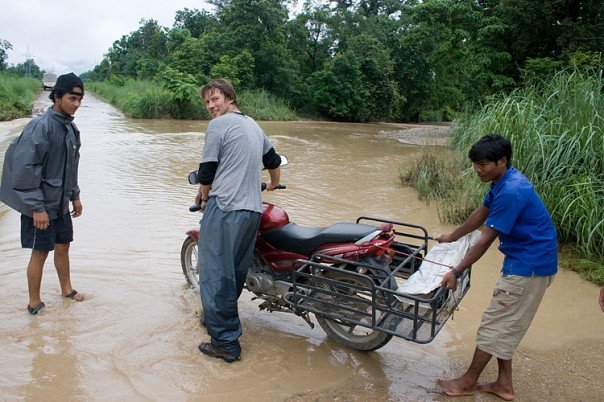
Well, that’s about it. I’ve probably missed a lot, but then a whole book can probably be written on the topic of motorcycle riding around India.
When alien worlds meet
I keep being reminded of just how different the world where I’m from is to the world where I now find myself. Perhaps no matter how many times I come to India things will always remain this way.For the past couple of days we’ve been trying to figure out how to make luggage carriers for my motorcycle. Getting involved in making anything in small town India often becomes a task of epic proportions - before long, everyone’s uncle’s, cousin’s son knows what you are doing. This can be good, as you can quickly track down the right people for the job, but quite often it is simply annoying – bored bystanders come to offer useless advice and opportunists try to cash in. After asking around we begin the search for a person who can do the job. The choice is very limited. Most of Junagadh’s inhabitants are very auspicious Hindus, many businesses are closed as the best time to re-open is on the fifth day after Diwali and that’s when we would ideally leave for our next destination. The first candidate for the job has his “office” - a wooden shack with a sewing machine next to a public urinal. I have to block my nose while I explain what we want. I’m thankful that he isn’t too interested - the smell is simply too much. The next candidate is much more pleasantly located – in a one-hundred-year-old courtyard, next to a Hindu temple. He is a pudgy, bald, mustached bag maker in his fifties – very welcoming and as it turns out very eccentric. He hands us his business card, which reads “NO GUARANTEES” in letters larger than anything else written on the card. He invites us to chat. Our conversation randomly detours, as conversations in India do, from the topic of bags, to feeding two hundred monkeys with three hundred rotis (a type of Indian bread) at the foot of the sacred Girnar Hill. That’s what the man does every Sunday and he proves it after insisting that we watch a VCD of this act. There is religious inspiration behind the man’s actions, but trying to understand his motives in depth is hard and I have long ago learned that understanding certain things in India can be bad for my sanity, I do not even try. After another change of topic it turns out that the monkey feeding bag maker is Hardik’s best friend Sandeep’s uncle. It is decided that he will make the luggage carriers, but the same evening Hardik rings to tell me that the man’s own nephew is not impressed with his work and does not recommend him. I remember “NO GUARANTEES” and think that perhaps it was put on the card for a reason. The next day we plan to buy the required materials and to meet the bag maker recommended by Sandeep, unfortunately the man isn’t keen on opening for business before the auspicious date and the plan is short lived. We decide to at least buy the materials and see what to do from there. Coincidentally Sandeep sells all the materials we require in his shop, but he too isn’t ready to re-open before the auspicious date. We turn to another option, to buy everything at the market, but suddenly Sandeep calls. He says that a client has pressured him to open early and this means that we can come by and get everything we need. When we arrive we see Sandeep standing outside of his shop with the rollers down. Five minutes pass, but Sandeep does not appear to be any closer to opening his shop. – Uh, em, why is the shop still closed? I ask. - I am waiting for the client. Sandeep replies through Hardik. – He should be here any minute. Knowing that in India ‘any minute’ can mean tomorrow or never I get edgy. – We are here and we are clients. So maybe Sandeep could open the shop? Hardik explains – We Hindus believe that once a shop is opened for the first time in the New Year a successful opening will mean a successful year. The first time the shop opens a sale must be made, we are not yet sure whether we will buy the materials in this shop. – Ok, we’ll definitely buy something. I say. – Oh, then it is ok! Hardik translates to Sandeep. The roller doors come up, Sandeep says a prayer and Tanya and I begin to look for something that we will definitely buy. Suddenly the client arrives, but Sandeep insists that we be the first to buy something, as we were first to arrive and our motives are supposedly more pure. We definitely need zippers and we take them to the counter. – How much for these two? – They are 7 rupees each, but I will charge 11 total, 11 is a lucky number. – Ok, whatever, great. Sandeep takes the money, says another prayer and now the other client can be served, while we pick out everything else that we need. – Hey, how much is this per meter? And this, and this? I enquire about a few items. Sandeep says something to Hardik in Gujarati, but I don’t hear numbers. – You cannot ask the price here. He is my best friend and you are like my brother, so this is like your shop. Just take what you need. Whatever the price will be, it will be the best price in town. I would have a hard time believing a line like this elsewhere, but Hardik is indeed like a brother. I know that young Indian men are very sensitive and as I simply want to get things done as soon as possible, I choose not to argue and go with the flow.
We got everything that we needed and in the end decided that we want to avoid drama and unexpected surprises. Tanya can make almost anything when it comes to working with fabrics, she will try to make the carriers herself using Sandeep’s sewing machine. As a result she is now out in the guesthouse’s communal hall, drawing up plans on the floor and cutting out pieces of fabric. I feel rather useless, the light is too harsh to shoot anything and I have already designed the carriers. I know that I will not have so much time in the near future and so I turn to typing this blog entry.
Recap of the first few days
I meant to post this a couple of days ago, but Diwali has kept Internet cafés closed here in Junagadh. The cab ride from Mumbai airport to the hotel reminds me why I am not crazy about this city. Huge billboards, wide, congested roads and some of the most pitiful slums one might encounter - these are not the things that I love about India. My wife Tanya and I decide to head off to Junagadh, my friend Hardik’s town as soon as possible. The next day at ‘India Railways Tourist Ticket Counter’ a woman with a rough, commanding voice violently taps at the keyboard with her long fingers, she looks at the computer screen and proclaims that it is impossible to travel where we want tonight. We plead with her to find a solution, she does – we have to get the train to Ahmedabad – a city that is an eight-hour bus trip away from Junagadh. I dread bus trips in India, but there is no other choice.
Our train arrives in Ahmedabad at 5 am. I take my almost immediate stepping into a pile of dog crap after disembarking as an official welcome back to the Indian Railways.
A riksha takes us towards the bus station; on the way we buy a ticket for the ‘deluxe bus’ to Junagadh from a shifty eyed travel agent. – "The deluxe bus is very best! Beautiful!" It will be here at 7 am. He says.
We wait and watch life go by. A vendor in front of us sweeps a pile of rubbish away from his stall into the spot of his neighbor. On a road clogged up with motorcycles, rikshas, cars and buses a couple of boys in a buffalo cart slowly make their way; they and the buffalo are oblivious to the modern motorized transport that rushes by. A young lion-haired man who looks and dresses like a Bollywood star checks himself out in the mirror and jumps into a riksha, while next to him a crowd of village women and children in colorful, raggedy clothes pours out of another riksha and head to the bus stand.
The bus is 40 minutes late. The journey is exhausting, but halfway through there is a pleasant surprise. I hear my name at a rest stop in the middle of nowhere. I turn around and see Hardik. We were meant to meet in Junagadh, his bus was to depart 3 hours later than ours, but the leisurely pace of the ‘very best, beautiful’ deluxe bus has meant that we have ended up at the same rest stop. A nice coincidence, but a frustrating realization of just how slow we are moving. We exchange hugs and briefly chat until our buses depart.
An unpleasant surprise comes as we near our destination. – Hello! Junagadh, riksha! Go, go! The bus is making a detour and Junagadh is no longer the planned destination. A few of the passengers, including us are crammed into a riksha that farts its way through a pot-holed road at a speed of 30km an hour for the remainder of the trip.
As we approach Junagadh my heart begins to beat faster. Having spent a lot of time in the town over the four times that I have been here, it is as close a place to home as there is for me in India.
I check into “Relief Hotel”, a pleasant and extremely helpful place, where the owner – Faiz, has become a good friend over the years. Minutes later Hardik arrives at the hotel and we go roaming around (as the Indians like to say).
A couple of hours later, exhausted, Tanya and I fall asleep in our room to the overwhelmingly loud noise of the firecrackers and fireworks outside. We miss the peak of the Diwali celebrations, but late in the evening we meet Hardik again and plan to catch what’s left of them.
The old part of town is still very much alive and full of people. Few tourists make it to Junagadh and Tanya and I attract attention wherever we go, for a moment we get away from the crowds and turn into a quiet lane. Unexpectedly we experience one of those surreal ‘only in India’ moments. Two bullocks with huge horns majestically pull a large cart filled with hay, atop the cart sits a bearded village man in a traditional white costume. The ruins of the old city are behind him and suddenly fireworks go off to light up the scene. Diwali is like Christmas and New Year at once and Tanya is quick to make the comparison of the bearded village man in the bullock cart to Santa Clause. A Junagadhi Santa Claus with bullocks in place of reindeer - I guess it’s true when photographers say that some of the best photos are the ones that only exist in our memories.
Diwali means that almost everything will be closed. I anticipate staying a few more days in Junagadh, at least until Hardik heads back to work. We’ll somehow have to sort out the motorcyle issues – the bike is in a bad need of servicing and I need to have luggage carriers made. Hopefully I’ll have at least something sorted out by the time of the next post.
And I’m off to India...again
Today I’m flying to India for the fourth time in the past 3 years. I love India like no other country, but I have been wanting to see other places (hence my recent Indonesia trip). I feel like I can spend my whole life in India and it still won’t be enough. I would see and photograph only a tiny part of what’s there. But that’s a big part of the attraction. I keep getting sucked inJ. I have a private workshop to teach, but I guess I just need any excuse.
For the first time I will not have an extended plan before I get to the country. I will spend Diwali in Junagadh (Gujarat) the hometown of my great friend Hardik. I left my motorcycle with him after my last trip, figuring that he could get some good use out of it for a few years. Well, I am back sooner than I expected and will deprive him of it. My wife and I will probably ride towards Bikaner, Rajasthan. I haven’t been there yet and since the workshop takes place in Rajasthan too it’s a good chance to see that area. Ooh, the joy of riding on the Indian roads again! Over the years I’ve embraced the chaos and now I think I feel more stressed in a car in Sydney, everything feels too orderly.
The workshop will go on for 17 days and nothing seems to be concrete after that, great but potentially disastrous from the standpoint of productivity. I have plenty of ideas for stories to shoot though, so I don’t think being unproductive is my biggest threat. India here we come again…
For those interested in what gear I’m taking:
I am only an occasional gear freak. For most part I don’t care what I shoot with, or what tools I use, as long as they do what I want them to do. However I do last for the 5D MKII.
Canon 5D (well the new one ain’t out yet!), Canon 24-70mm f 2.8, Sigma 20mm f 1.8
Self explanatory…I think.
Canon 580 EX II Flash + ST-E2 Trasmitter along with a portable softbox from Photoflex, as well as a while bunch of gels.
These really got a lot of use during my last Indonesia trip. It’s great what you can do with a flash and whatever that is becomes even better when it’s an off camera flash. Thanks to my wife Tanya for holding it in the most awkward of situations.
Two 8GB cards and a bunch of 2GB and 1GB cards. Two portable HDDs 250GB and 160GB, I like Seagate. I have not replaced my broken Hyperdrive Color Space. It was one great gadget, if only it could withstand hits against a concrete floor. One banged up old Dell laptop. I am proud of how much use I have gotten out of this thing. Still does most of the work I need and even seems to withstand the hits against a concrete floor.



